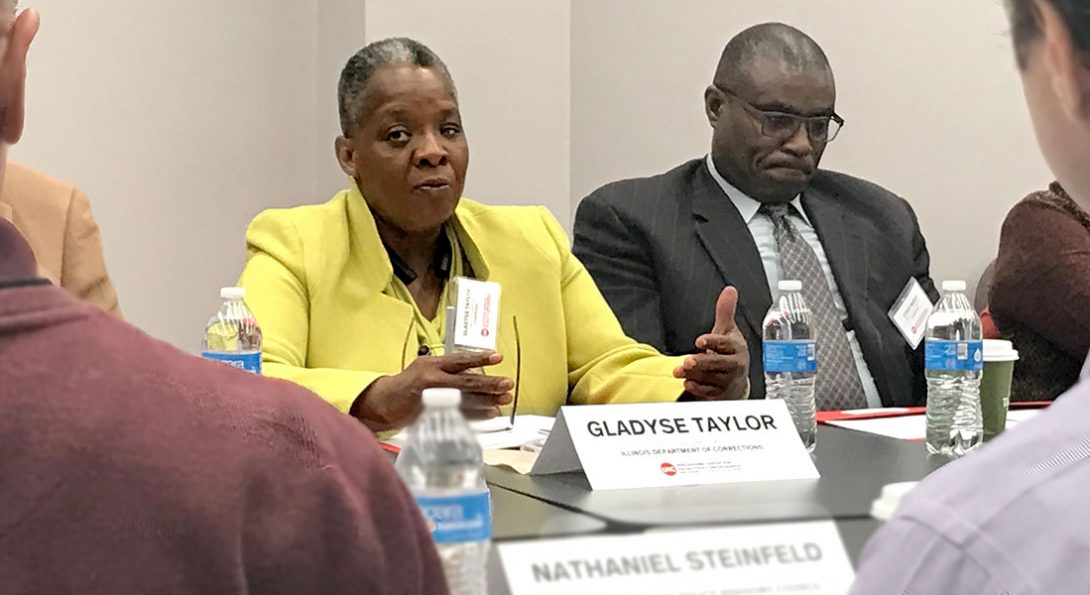IDOC Assistant Director Attends Summit to Address Aging Prison Populations

On Thursday, May 11, 2017, the Jane Addams Center for Social Policy and Research (Policy Center) in partnership with the Illinois Department of Corrections (IDOC) held a half-day community summit at the University of Illinois at Chicago Jane Addams College of Social Work (JACSW).
The event, titled A Summit on Reentry, Reintegration and Aging, hosted twenty-eight participants which included staff and faculty from JACSW, IDOC key staff members, and leadership from community based organizations that serve returning prisoners, former prisoners and family members of current prisoners. The goal of the event was to identify effective reentry practices, policies and programs for older prisoners.
The Summit’s focus was centered on two topics:
- The problems and complications associated with the incarceration of older adults and how these problems impact outcomes after their release, and
- The unique needs of older prisoners when they are released and the resources needed to help them transition back to communities.
The Summit opened with welcoming remarks from Dr. Creasie Finney Hairston, Dean of JACSW and Director of the Policy Center, and from Gladyse C. Taylor, Assistant Director of IDOC.
Following the welcoming remarks, JACSW Associate Professor Aaron Gottlieb provided an overview of the current research on older prisoner populations in the United States and in Illinois:
Trends in the Older Inmate Population in U.S. and Illinois
- The number of older inmates is increasing much faster than the total prison population both in the United States and in Illinois.
- From 1995 to 2010, the total U.S. prison population (state and federal) increased by 42%, while the prison population age 55+ increased by 282%.
- At the state level, while the total prison population in Illinois increased by 6% from 2005 to 2015, the older prison population age 55+ increased by 169%.
The Causes of the Increase in the Older Prison Population
- The reason for the increase in the number of older prisoners throughout the carceral system, nationwide as well as in Illinois, can be attributed to various factors including tougher sentencing practices, such as mandatory minimum sentencing, three-strikes and truth in sentencing laws, as well as the increased use of life sentences.
- Another factor is that correctional and parole officials lack the legal authority to release older prisoners prior to the expiration of their sentence.
- Perhaps less of a contributing factor, but still statistically relevant, is the recent uptick of crimes being committed by people 55 years of age and older.
Reasons to Consider Reducing the Older Prison Population
- Older prisoners have different needs than younger prisoners, especially in terms of healthcare, which are difficult for prisons and prison staff to meet as the older prison population gradually eclipses the younger.
- Older prisoners are twice as expensive to incarcerate as the average prisoner, so reducing older prison populations would lead to cost savings.
- Crime rates decline substantially as people age, so older prisoners represent less of a public safety risk than younger offenders.
Following this presentation were three community dialogues, facilitated by Joseph Strickland, PhD, Associate Directors of the Policy Center, and JACSW Associate Professor Branden McLeod. The dialogues focused on the following three questions:
- What issues do older prisoners face in prison and what challenges do prison administrators and staff face when working with this population?
- What are the community reentry and reintegration experiences of older prisoners and what policies and programs are in place to facilitate successful reentry?
- What are the lessons learned from implementing, participating in, and researching policies and practices that prevent recidivism, increase community safety, and enhance the individual and well-being of older returning prisoners?